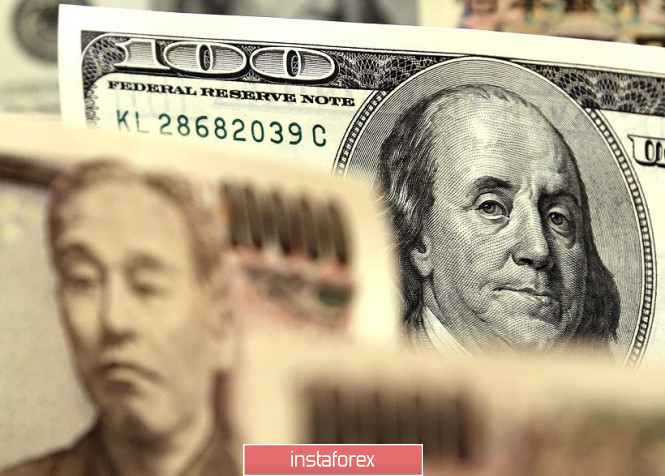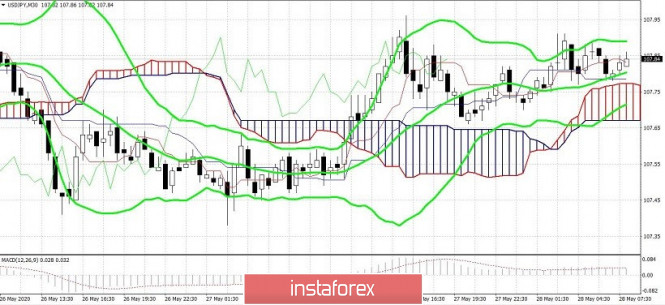The yen continues to trade in a narrow price range against the dollar, despite the rapid news flow. The international scandal surrounding Hong Kong, the mutual threats of Washington and Beijing, the decline in oil prices, additional incentives from the Japanese authorities - these, and many other fundamental factors are ignored by USD/JPY traders. This is partly due to the fact that both the dollar and the yen enjoy the status of protective assets, and the pair de facto stands still amid general nervousness. But analyzing the behavior of the yen in cross pairs, we can conclude that traders are very wary of the Japanese currency. Even the latest news from Japan, which at first glance was supposed to support JPY, simply went unnoticed. This means that the pair retains the potential for its growth, and is now in standby mode, waiting for powerful information that would help the bulls gain a foothold in the 108th figure.
It should be noted here that the bulls ignored a really important fundamental factor. Yesterday it became known that the Japanese authorities allocated the largest package of financial assistance in the world: the total volume of injections will be more than $2 trillion, which is approximately 40% of GDP. In this case, only the United States is ahead of the Japanese, with a total of 2.3 trillion allocated. The structure of Japanese incentives also includes large direct costs, the total amount of which will be about 330 billion dollars. In addition, a package worth $1.1 trillion will be spent on financial assistance to factories and companies, subsidies for rent and medical assistance. This incentive program will be partially funded by the issuance of a public debt of nearly 32 trillion yen in the framework of the second additional budget of the country for the current fiscal year, which ends April 1, 2021.

All this suggests that the Bank of Japan will continue to keep rates low, while continuing to aggressively buy bonds. Perhaps it was precisely these conclusions that cooled the ardor of bears, who actually ignored such record financial injections from the state. At the same time, similar intentions on the part of the European Commission caused a violent reaction from the European currency (which has significantly risen in price throughout the market). The dollar also rose in price at the relevant decisions of Congress. But the yen showed only a formal and very short-term reaction - the pair decreased by about 50 points only for a couple of hours.
It is also worth recalling that at the beginning of this week, traders calmly reacted to the results of an emergency meeting of the Bank of Japan. But here, the regulator itself did not provide any reasons for volatility: contrary to numerous rumors and fears, the BOJ did not expand the stimulus program and did not lower the interest rate. Kuroda only announced his intentions to extend the loan program from the previous three-month period to the current six-month period. The market was absolutely ready for the implementation of this scenario, and the regulator, in turn, did not bring any additional surprises.
But in general, ignoring the above fundamental factors is indicative. The Japanese economy is in the stage of a technical recession, and this fact, apparently, alarms traders, frightens them from the yen. The dolla behaves in different directions, temporarily becoming more expensive only on spurts of anti-risk sentiment in the market. These bursts are very short-term, so the dollar index over the past few days has fluctuated at the boundary of 98 and 99 figures. We can assume that the market is waiting for the Hong Kong issue to be resolved: in the near future, China should decide on a resonant bill that will strengthen Beijing's influence in Hong Kong, while in Washington they should decide on the response measures that Donald Trump has already announced. According to him, the White House is preparing "something powerful", without specifying what it is about.
But it is worth noting here that if the political conflict between the United States and China does not affect the trade deal that representatives of these countries concluded last year, the market reaction may be short-term. The pair can gain a foothold in the 108th figure, increasing the price level by only one step. But if the conflict goes into the economic plane, then in this case, buyers can count on the range of 109-110.
In other words, the prospects for the pair directly depend on the further steps of Beijing and Washington. And if the actions of China are very predictable (the Chinese parliament will probably adopt the above law), then the US is intriguing. The fate of the pair depends on its resolution.


From a technical point of view, the situation is also uncertain: on the daily chart, the pair is in the Kumo cloud, between the middle and lower lines of the Bollinger Bands indicator and between the lines of Tenkan-sen and Kijun-sen of the Ichimoku indicator. The bulls need to exceed the upper border of the above cloud (108.50) in order to confirm the strength of the upward movement - until this moment all purchases will look risky. In turn, to confirm the downward movement, the bears need to gain a foothold below 107.00 (the middle line of the Bollinger Bands indicator is at D1), and for greater certainty - go to the middle of the 106th figure. In the meantime, the pair fluctuates between the above levels, any scenario has the right to life: everything will depend on the overall fundamental picture. If we talk about the short term, then on the 30-minute chart the pair will most likely push off from the lower border of the Kumo cloud (107.60) and test the high of 107.96 daily, attempting to storm the 108th figure. But to consolidate in this price area, a sufficiently powerful informational reason is needed, which is not yet available.
The material has been provided by InstaForex Company - www.instaforex.com